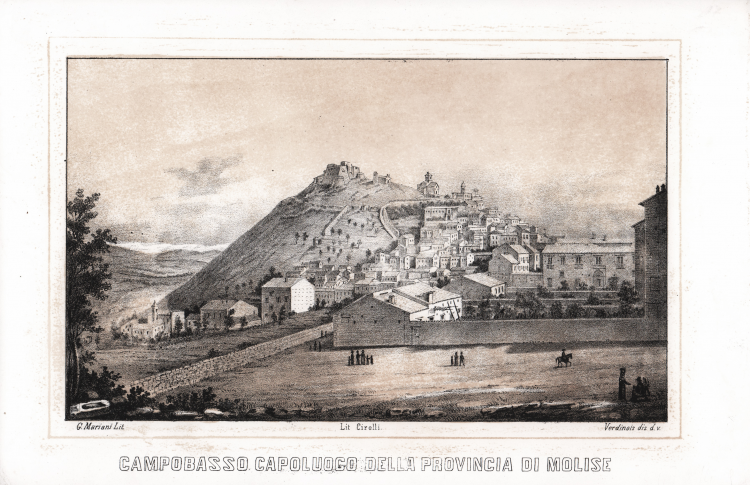



| Reference: | S40682.32 |
| Author | Filippo CIRELLI |
| Year: | 1853 |
| Zone: | Campobasso |
| Printed: | Naples |
| Measures: | 315 x 205 mm |


| Reference: | S40682.32 |
| Author | Filippo CIRELLI |
| Year: | 1853 |
| Zone: | Campobasso |
| Printed: | Naples |
| Measures: | 315 x 205 mm |
Panoramic view drawn by Verdinois, taken from: Il regno delle Due Sicilie descritto ed illustrato ovvero descrizione topografica, storica, monumentale, industriale, artistica economica e commerciale delle provincie poste al qua e al di là del faro e di ogni paese di esse: Opera dedicata alla maestà di Ferdinando 2. / Antonio Racioppi; a cura di Filippo Cirelli. - Naples: G. Nobile, 1853.
The work, which began to be printed in 1853, remained unfinished due to the death of its editor and the end of the Neapolitan kingdom. The Kingdom described and illustrated retraced and expanded the lines of investigation that some decades earlier had already covered other works and other scholars, such as the Description of Giuseppe Del Re or the Dictionary of Lorenzo Giustiniani.
The volume is accompanied by numerous lithographs. He sensed that “popular traditions are a primary element to clarify and document the life and spiritual process of a land”.
Lithograph, some spotting but generally in good conditions. Rare.
Filippo CIRELLI (Campoli Appennino 1796 - Napoli 1867)
|
Filippo Cirelli was an inventor, publisher, professor, sculptor, and painter originally from Campoli Appennino. Cirelli came from a fairly wealthy family: his father, Francesco, was a local notary, while his mother, Rosa Orlandi, was of noble birth. He completed his studies at the seminary in Sora then left for Naples, where he devoted himself to the physical, mathematical and chemical sciences under the guidance of Prof. Lorenzo Fazzini, whose assistant he soon became. In 1827 he became a teacher of drawing in the secondary schools of the Royal Institute of Fine Arts, of which he became an honorary professor. Sensing the developments of galvanoplasty, discovered by Jacobi, he wants to apply it to his polygraphic establishment, succeeding in obtaining the reproduction of drawings by means of clichès. He is the inventor of "Galvanotypia" or "Electrotypia" and receives an honorary mention from the Institut de France. Cirelli is also credited with the invention of the "Lithotype," by which already printed drawings were reproduced through chemical preparations on lithographic stone. Cirelli also devoted himself to publishing: in his polygraphic establishment in Naples he edited rare works with undeniable artistic, scientific, literary and historical value. He prints the "Poliorama Pittoresco" a periodical work with a variety of topics with the merit of making knowledge accessible to the people. He gives to the presses other journals such as: Giornale Scientifico, artistico e industriale, Il Lucifero, Moda, La medicina pittoresca. The work that gives him the most luster is Il Regno delle Due Sicilie descritto ed illustrato. Descrizione tipografica, storica, monumentale, industriale, economica e commerciale delle province al di qua e al di là del Faro e di ogni singolo paese di esse” dedicated to King Ferdinand II. It is a history of humanity as seen through the traditions, habits, customs and habits of the inhabitants. This series of monographs was the best that then existed in southern Italy and was praised by the best historiographers, including Marinelli. It remained unfinished due to Cirelli's death in 1867.
|
Filippo CIRELLI (Campoli Appennino 1796 - Napoli 1867)
|
Filippo Cirelli was an inventor, publisher, professor, sculptor, and painter originally from Campoli Appennino. Cirelli came from a fairly wealthy family: his father, Francesco, was a local notary, while his mother, Rosa Orlandi, was of noble birth. He completed his studies at the seminary in Sora then left for Naples, where he devoted himself to the physical, mathematical and chemical sciences under the guidance of Prof. Lorenzo Fazzini, whose assistant he soon became. In 1827 he became a teacher of drawing in the secondary schools of the Royal Institute of Fine Arts, of which he became an honorary professor. Sensing the developments of galvanoplasty, discovered by Jacobi, he wants to apply it to his polygraphic establishment, succeeding in obtaining the reproduction of drawings by means of clichès. He is the inventor of "Galvanotypia" or "Electrotypia" and receives an honorary mention from the Institut de France. Cirelli is also credited with the invention of the "Lithotype," by which already printed drawings were reproduced through chemical preparations on lithographic stone. Cirelli also devoted himself to publishing: in his polygraphic establishment in Naples he edited rare works with undeniable artistic, scientific, literary and historical value. He prints the "Poliorama Pittoresco" a periodical work with a variety of topics with the merit of making knowledge accessible to the people. He gives to the presses other journals such as: Giornale Scientifico, artistico e industriale, Il Lucifero, Moda, La medicina pittoresca. The work that gives him the most luster is Il Regno delle Due Sicilie descritto ed illustrato. Descrizione tipografica, storica, monumentale, industriale, economica e commerciale delle province al di qua e al di là del Faro e di ogni singolo paese di esse” dedicated to King Ferdinand II. It is a history of humanity as seen through the traditions, habits, customs and habits of the inhabitants. This series of monographs was the best that then existed in southern Italy and was praised by the best historiographers, including Marinelli. It remained unfinished due to Cirelli's death in 1867.
|